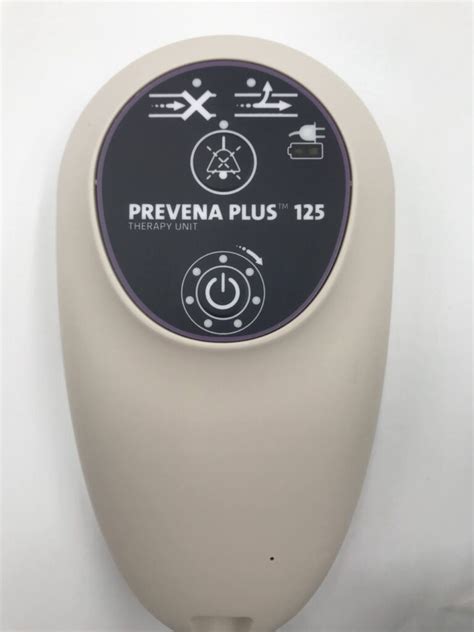Prevena Plus 125 is a type of negative pressure wound therapy (NPWT) system designed to promote wound healing and reduce the risk of complications in patients with chronic or acute wounds. This medical device is part of a broader category of wound care products that have revolutionized the way healthcare professionals manage wounds. The Prevena Plus 125 system is particularly notable for its application in the management of closed surgical incisions, where it can help minimize the risk of infection and promote faster healing.
Key Principles of Negative Pressure Wound Therapy

Negative pressure wound therapy, also known as vacuum-assisted closure, involves the application of a vacuum dressing to enhance and promote wound healing in acute, chronic, and burn wounds. This technique has been shown to accelerate the healing process by improving tissue perfusion, reducing edema, and promoting the formation of granulation tissue. The Prevena Plus 125 system is designed to apply a controlled negative pressure to the wound environment, which helps to draw out excess fluids, reduce swelling, and bring the edges of the wound closer together.
Components and Operation of Prevena Plus 125
The Prevena Plus 125 system consists of a portable unit that generates the negative pressure, a canister to collect fluid, and a dressing kit that includes a foam or gauze dressing and a film dressing. The system is designed to be user-friendly, allowing healthcare providers to easily apply and manage the therapy. The dressing is placed over the wound, and the negative pressure is applied through the tubing connected to the portable unit. The system can be programmed to deliver continuous or intermittent negative pressure, depending on the specific needs of the patient.
| Feature | Description |
|---|---|
| Pressure Settings | Continuous or intermittent negative pressure adjustable from -75mmHg to -125mmHg |
| Portability | Battery-operated, lightweight design for ease of transport |
| Alarm System | Visual and audible alarms for low battery, blockage, or loss of pressure |
| Fluid Collection | Canister for collection of wound exudate, with a capacity of up to 300ml |

Clinical Evidence and Outcomes

A growing body of clinical evidence supports the use of negative pressure wound therapy, including the Prevena Plus 125 system, in various wound types. Studies have shown that NPWT can reduce the time to wound closure, decrease the risk of wound complications, and improve patient outcomes. The therapy has been used successfully in a variety of settings, from acute care hospitals to home healthcare, underscoring its versatility and effectiveness.
Challenges and Limitations
While the Prevena Plus 125 system offers numerous benefits, there are challenges and limitations to its use. These include the need for proper training in the application and management of the therapy, potential skin irritation or other adverse effects, and the importance of ongoing wound assessment and adjustment of the therapy as needed. Furthermore, the cost of the system and the necessity for a comprehensive wound care plan that includes regular dressing changes and monitoring can be barriers to access for some patients.
Key Points
- The Prevena Plus 125 system is a type of negative pressure wound therapy designed to promote wound healing and reduce complications.
- It applies controlled negative pressure to the wound environment to enhance tissue perfusion, reduce edema, and promote granulation tissue formation.
- The system consists of a portable unit, a canister, and a dressing kit, making it suitable for use in various healthcare settings.
- Clinical evidence supports the use of NPWT in reducing wound healing time and decreasing the risk of complications.
- Proper training, wound assessment, and management are crucial for the effective and safe use of the Prevena Plus 125 system.
In conclusion, the Prevena Plus 125 system represents a significant advancement in wound care, offering a proven method for promoting healing and reducing the risk of complications in patients with chronic or acute wounds. Its application in post-surgical care, particularly for closed surgical incisions, highlights its potential to improve patient outcomes and reduce healthcare costs associated with wound management. As with any medical therapy, careful patient selection, proper application, and ongoing management are essential to maximizing the benefits of this technology.
What is the primary mechanism of action of the Prevena Plus 125 system?
+The primary mechanism of action involves the application of controlled negative pressure to the wound environment, which enhances tissue perfusion, reduces edema, and promotes the formation of granulation tissue.
What types of wounds can be treated with the Prevena Plus 125 system?
+The Prevena Plus 125 system can be used for a variety of wound types, including chronic wounds such as diabetic foot ulcers, venous ulcers, and pressure ulcers, as well as acute wounds like surgical incisions and traumatic wounds.
How is the Prevena Plus 125 system typically used in a clinical setting?
+The system is typically used under the guidance of a healthcare professional who applies the dressing and sets the appropriate negative pressure settings based on the patient’s wound type and healing stage.



